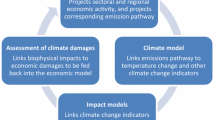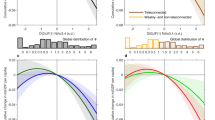Abstract
The integrated assessment model FUND 2.8n is applied in an assessment to estimate the magnitude of the general market and non-market impacts of temperature changes caused by a possible shutdown of the thermohaline circulation (THC). The monetized impacts of this change in environmental conditions are determined for 207 individual countries for two scenarios: one warming scenario in which the THC weakens but remains intact, and another in which the THC breaks down. Eight different response patterns are identified. The dominant pattern is that a THC shutdown has an offsetting effect on the underlying warming trend. Depending on whether the impacts of warming are initially beneficial or detrimental, the economic effects of a THC shutdown show distinct regional variability. Key economic sectors affected are water resources and energy consumption, as well as cardiovascular and respiratory diseases among health impacts. The maximum national impact of a shutdown of the THC turns out to be of the magnitude of a few per cent of GDP, but the average global impact is much smaller. The results indicate that the temperature effect of a THC shutdown does not create an insurmountable economic threat on a global scale, but may cause severe damages to individual countries. However, a consideration of other climatic impacts such as precipitation and sea level changes is likely to alter the identified trends in economic development.
Article PDF
Similar content being viewed by others
Avoid common mistakes on your manuscript.
References
Bijlsma L et al (1996) Coastal zones and small islands. In: Watson RT et al (eds) Climate change 1995: impacts, adaptation and mitigation of climate change: scientific technical analyses. Contribution of working group II to the second assessment report of the Intergovernmental Panel on Climate Change, Cambridge University Press, Cambridge, pp 289–324
Bosello F, Roson R, Tol RSJ (2007) Economy-wide estimates of the implications of climate change: sea level rise. Environ Resour Econ 37:549–571
Ceronsky M, Anthoff D, Hepburn CJ, Tol RSJ (2005) Checking the price tag on catastrophe: the social cost of carbon under non-linear climate response. Working paper FNU-87, Research Unit Sustainability and Global Change, Hamburg University
Darwin RF et al (1995) World agriculture and climate change—economic adaptations. US Department of Agriculture, Washington
Downing TE et al (1996) Full fuel cycle study: evaluation of the global warming externality for fossil fuel cycles with and without CO2 abatement and for two reference scenarios. Environmental Change Unit, Oxford University, Oxford
Fankhauser S (1994) Protection vs retreat—the economic cost of sea level rise. Environ Plann A 27:299–319
Fankhauser S, Tol RSJ (2005) On climate change and economic growth. Resour Energy Econ 27:1–17
Fankhauser S, Tol RSJ, Pearce DW (1997) The aggregation of climate change damages: a welfare theoretic approach. Environ Resour Econ 10:249–266
Fankhauser S, Tol RSJ, Pearce DW (1998) Extensions and alternatives to climate change impact valuation: on the critique of IPCC working group III’s impact estimates. Environ Dev Econ 3:59–81
Fischer G et al (1996) Impacts of potential climate change on global and regional food production and vulnerability. In: Downing TE (ed) Climate change and world food security. Springer, Berlin, pp 115–159
Fischer G, Shah M, Tubiello FN, van Velhuizen H (2005) Socio-economic and climate change impacts on agriculture: an integrated assessment, 1990–2080. Philos Trans R Soc B 360:2067–2083
Gordon C et al (2000) The simulation of SST, sea-ice extents and ocean heat transport in a version of the Hadley Centre coupled model without flux adjustments. Clim Dyn 16:147–168
Gregory JM et al (2005) A model intercomparison of changes in the Atlantic thermohaline circulation in response to increasing atmospheric CO2 concentration. Geophys Res Lett 32:L12703
Hamilton JM, Maddison DJ, Tol RSJ (2005) The effects of climate change on international tourism. Clim Res 29:255–268
Higgins PAT, Vellinga M (2004) Ecosystem responses to abrupt climate change: teleconnections, scale and the hydrological cycle. Clim Change 64:127–142
Hoozemans FMJ, Marchand M, Pennekamp HA (1993) A global vulnerability analysis: vulnerability assessment for population, coastal wetlands and rice production on a global scale, 2nd edn. Delft Hydraulics, The Netherlands
Houghton JT et al (1995) Climate change 1995. Cambridge University Press, Cambridge
Kane S, Reilly JM, Tobey J (1992) An empirical study of the economic effects of climate change on world agriculture. Clim Change 21:17–35
Kattenberg A et al (1996) Climate models-projections of future climate. In: Houghton JT et al (ed) Climate change 1995: the science of climate change. Cambridge University Press, Cambridge, pp 285–357
Keller K, Bolker BM, Bradford DF (2004) Uncertain climate thresholds and optimal economic growth. J Environ Econ Manage 48:723–741
Köhler P, Joos F, Gerber S, Knutti R (2005) Simulated changes in vegetation distribution, land carbon storage, and atmospheric CO2 in response to a collapse of the North Atlantic thermohaline circulation. Clim Dyn 25:689–708
Kuhlbrodt T et al (2009) An integrated assessment of changes in the thermohaline circulation. Clim Change 96:489–537
Leggett J, Pepper WJ, Swart RJ (1992) Emissions scenarios for the IPCC: an update. In: Houghton JT, Callander BA, Varney SK (eds) Climate change 1992. The supplementary report to the IPCC Scientific Assessment, vol 1, 1st edn, Cambridge University Press, Cambridge, pp 71–95
Lenton TM et al (2008) Tipping elements in the Earth’s climate system. Proc Natl Acad Sci U S A 105:1786–1793
Levermann A, Griesel A, Hofmann M, Montoya M, Rahmstorf S (2005) Dynamic sea level changes following changes in the thermohaline circulation. Clim Dyn 24:347–354
Link PM, Tol RSJ (2004) Possible economic impacts of a shutdown of the thermohaline circulation: an application of FUND. Port Econ J 3:99–114
Link PM, Tol RSJ (2006) Economic impacts on key Barents Sea fisheries arising from changes in the strength of the Atlantic thermohaline circulation. ICES J Mar Sci 63(4):611–625
Link PM, Tol RSJ (2009) Economic impacts on key Barents Sea fisheries arising from changes in the strength of the Atlantic thermohaline circulation. Glob Environ Change 19:422–433
Manabe S, Stouffer RJ (1994) Multiple-century response of a coupled ocean-atmosphere model for an increase of atmospheric carbon dioxide. J Climate 7:5–23
Martens WJM (1998) Climate change, thermal stress and mortality changes. Soc Sci Med 46(3):331–344
Meehl GA et al (2007) Global climate projections. In: Solomon S et al (eds) Climate change 2007: the physical science basis. Contribution of working group I to the fourth assessment report of the intergovernmental panel on climate change, Cambridge University Press, Cambridge
Mikolajewicz U, Gröger M, Maier-Reimer E, Schurgers G, Vizcaíno M, Winguth AME (2007) Long-term effects of anthropogeneic CO2 emissions simulated with a complex earth system model. Clim Dyn 28:599–633
Nævdal E, Oppenheimer M (2007) The economics of the thermohaline circulation—a problem with multiple thresholds of unknown locations. Resour Energy Econ 29:262–283
Nicholls RJ, Tol RSJ (2006) Impacts and responses to sea-level rise: a global analysis of the SRES scenarios over the twenty-first century. Philos Trans R Soc A 364:1073–1095
Nicholls RJ, Tol RSJ, Vafeidis AT (2008) Global estimates of the impact of a collapse of the West Antarctic ice sheet: an application of FUND. Clim Change 91:171–191
Perez-Garcia JM et al (1997) Economic impacts of climatic change on the global forest sector: an integrated ecological/economic assessment. Crit Rev Environ Sci Technol 27:S123–S138
Rahmstorf S, Ganopolski A (1999) Long-term global warming scenarios computed with an efficient coupled climate model. Clim Change 43:353–367
Sohngen B, Mendelsohn R, Sedjo R (2001) A global model of climate change impacts on timber markets. J Agric Resour Econ 26(2):326–343
Stocker TF, Schmittner A (1997) Influence of CO2 emission rates on the stability of the thermohaline circulation. Nature 388:862–865
Stouffer RJ et al (2006) Investigating the causes of the response of the thermohaline circulation to past and future climate changes. J Climate 19:1365–1387
Tol RSJ (1995) The damage costs of climate change—towards more comprehensive calculations. Environ Resour Econ 5:353–374
Tol RSJ (1999) Spatial and temporal efficiency in climate change: applications of FUND. Environ Resour Econ 14:33–49
Tol RSJ (2002a) Estimates of the damage costs of climate change. Part I: benchmark estimates. Environ Resour Econ 21:47–73
Tol RSJ (2002b) Estimates of the damage costs of climate change. Part II: dynamic estimates. Environ Resour Econ 21:135–160
Tol RSJ (2009) The economic effects of climate change. J Econ Perspect 23:29–51
Tsigas ME, Frisvold GB, Kuhn B (1996) Global climate change in agriculture. In: Hertel TW (ed) Global trade analysis: modelling and applications. Cambridge University Press, Cambridge
Vellinga M (2004) Robustness of climate response in HadCM3 to various perturbations of the Atlantic meridional overturning circulation. Hadley Centre technical notes, Exeter
Vellinga M, Wood RA (2002) Global climatic impacts of a collapse of the Atlantic thermohaline circulation. Clim Change 54:251–267
Vellinga M, Wood RA (2008) Impacts of thermohaline circulation shutdown in the twenty-first century. Clim Change 91:43–63
Wood RA, Keen AB, Mitchell JFB, Gregory JM (1999) Changing spatial structure of the thermohaline circulation in response to atmospheric CO2 forcing in a climate model. Nature 399:572–575
Wood RA, Vellinga M, Thorpe RB (2003) Global warming and thermohaline circulation stability. Philos Trans R Soc A 361:1961–1975
Wood RA et al (2006) Towards a risk assessment for shutdown of the atlantic thermohaline circulation. In: Schellnhuber et al (eds) Avoiding dangerous climate change. Cambridge University Press, Cambridge
World Health Organization (WHO) (1995) Global burden of disease database. http://www.who.int/topics/global_burden_of_disease/en/. Cited 8 May 2008
Zickfeld K et al (2007) Expert judgments on the response of the Atlantic meridional overturning circulation to climate change. Clim Change 82:235–265
Author information
Authors and Affiliations
Corresponding author
Rights and permissions
Open Access This is an open access article distributed under the terms of the Creative Commons Attribution Noncommercial License (https://creativecommons.org/licenses/by-nc/2.0), which permits any noncommercial use, distribution, and reproduction in any medium, provided the original author(s) and source are credited.
About this article
Cite this article
Link, P.M., Tol, R.S.J. Estimation of the economic impact of temperature changes induced by a shutdown of the thermohaline circulation: an application of FUND . Climatic Change 104, 287–304 (2011). https://doi.org/10.1007/s10584-009-9796-7
Received:
Accepted:
Published:
Issue Date:
DOI: https://doi.org/10.1007/s10584-009-9796-7




